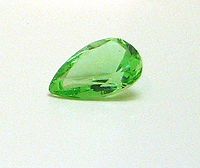
Dresden Green Diamond
Encyclopedia

Diamond
In mineralogy, diamond is an allotrope of carbon, where the carbon atoms are arranged in a variation of the face-centered cubic crystal structure called a diamond lattice. Diamond is less stable than graphite, but the conversion rate from diamond to graphite is negligible at ambient conditions...
, which probably originated in the Kollur mine
Kollur Mine
The Kollur Mine in Guntur district of old Golkonda kingdom, India, was one of the most productive diamond mines in India and the first major diamond center. It is situated on the right bank of the river Krishna. It operated between the sixteenth and mid-nineteenth centuries...
in the state of Andhra Pradesh
Andhra Pradesh
Andhra Pradesh , is one of the 28 states of India, situated on the southeastern coast of India. It is India's fourth largest state by area and fifth largest by population. Its capital and largest city by population is Hyderabad.The total GDP of Andhra Pradesh is $100 billion and is ranked third...
in the Indian subcontinent
Indian subcontinent
The Indian subcontinent, also Indian Subcontinent, Indo-Pak Subcontinent or South Asian Subcontinent is a region of the Asian continent on the Indian tectonic plate from the Hindu Kush or Hindu Koh, Himalayas and including the Kuen Lun and Karakoram ranges, forming a land mass which extends...
.
The Dresden Green is a rare Type IIa, and it is said to be internally flawless.
It is named after Dresden
Dresden
Dresden is the capital city of the Free State of Saxony in Germany. It is situated in a valley on the River Elbe, near the Czech border. The Dresden conurbation is part of the Saxon Triangle metropolitan area....
, the capital of Saxony
Saxony
The Free State of Saxony is a landlocked state of Germany, contingent with Brandenburg, Saxony Anhalt, Thuringia, Bavaria, the Czech Republic and Poland. It is the tenth-largest German state in area, with of Germany's sixteen states....
, Germany
Germany
Germany , officially the Federal Republic of Germany , is a federal parliamentary republic in Europe. The country consists of 16 states while the capital and largest city is Berlin. Germany covers an area of 357,021 km2 and has a largely temperate seasonal climate...
where it has been on display for most of the last two centuries. Today, the diamond is shown in the "New Green Vault" at Dresden Castle
Dresden castle
Dresden Castle is one of the oldest buildings in Dresden. For almost 400 years, it has been the residence of the electors and kings of Saxony...
.
History
The Dresden Green Diamond has a historical record dating back to 1722, when a London news-sheet carried an article about it in its 25 October-27th edition. It was acquired by Augustus III of PolandAugustus III of Poland
Augustus III, known as the Saxon ; ; also Prince-elector Friedrich August II was the Elector of Saxony in 1733-1763, as Frederick Augustus II , King of Poland and Grand Duke of Lithuania in 1734-1763.-Biography:Augustus was the only legitimate son of Augustus II the Strong, Imperial Prince-Elector...
from a Dutch merchant in 1742 at the Leipzig Fair
Leipzig Trade Fair
The Leipzig Trade Fair was a major fair for trade across Central Europe for nearly a millennium. After the Second World War, its location happened to lie within the borders of East Germany, whereupon it became one of the most important trade fairs of Comecon and was traditionally a meeting place...
. In 1768, the diamond was incorporated into an extremely valuable hat ornament, surrounded by two large and 411 medium-sized and small diamonds. This is the setting that the Dresden Green still appears in today.
In 2000, American jeweler, Harry Winston
Harry Winston
Harry Winston was an American jeweler. He donated the Hope Diamond to the Smithsonian Institution in 1958 after owning it for a decade, and traded the Portuguese Diamond to the Smithsonian in 1963.-History:...
arranged to display the Dresden Green in his New York store and then at the Smithsonian in Washington DC, USA, where it was displayed in the Harry Winston pavilion next to the largest blue diamond in the world, the Hope diamond
Hope Diamond
The Hope Diamond, also known as "Le bleu de France" or "Le Bijou du Roi", is a large, , deep-blue diamond, now housed in the Smithsonian Natural History Museum in Washington, D.C. It is blue to the naked eye because of trace amounts of boron within its crystal structure, but exhibits red...
.

